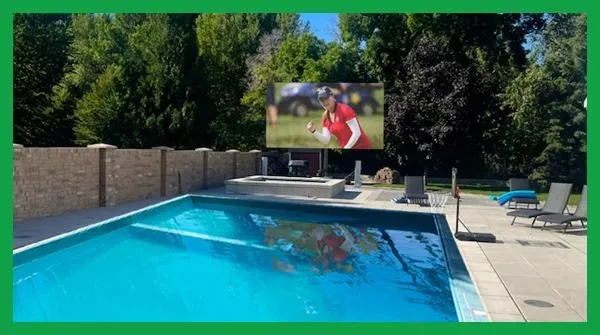

YOLO TV Learning Center
YOLO TV Learning Center

Waterproof Outdoor TVs vs. Non-Waterproof Outdoor TVs: What's the Difference?
Creating the perfect outdoor entertainment space involves many considerations, and choosing the right outdoor TV is one of the most critical. One of the main decisions you'll face is whether to go with a waterproof outdoor TV vs a non-waterproof outdoor TV. Understanding the differences between these two options can help you make an informed decision that ensures longevity, durability, and the best viewing experience for your backyard setup.
What is a Waterproof Outdoor TV?
A waterproof outdoor TV is specifically designed to withstand exposure to water and other elements. These TVs have sealed enclosures that protect the internal components from rain, snow, humidity, and even accidental splashes from a pool or sprinkler. Waterproof outdoor TVs often have a higher Ingress Protection (IP) rating, which indicates their level of protection against dust and water. A high IP rating, such as IP65 or above, ensures that the TV can handle being exposed to the elements without damage.
YOLO TVs are designed specifically for being fully outdoors, for any type of weather. We make sure our TV is tested in a controlled environment with simulations to ensure your TV is ready for anything mother nature has in mind. And since our tvs are enteneered to specifications of your backyard environment with soil type, terrain, climate and specific details you can be rest assured your TV is safe and ready for the elements.
Key Features of Waterproof Outdoor TVs:
1. Sealed Enclosures: These TVs are built with sealed cases to keep out moisture, dust, and insects.
2. Corrosion-Resistant Materials: Materials used in waterproof outdoor TVs are resistant to rust and corrosion.
3. Enhanced Durability: Designed to operate in extreme temperatures and varying weather conditions.
4. UV Protection: Screens are often treated with UV protection to prevent sun damage and fading.

What is a Non-Waterproof Outdoor TV?
Non-waterproof outdoor TVs, while designed for outdoor use, are not fully protected against direct exposure to water. These TVs may offer some level of resistance to weather elements but generally require additional protection or placement in covered areas to ensure their longevity. Non-waterproof outdoor TVs are more vulnerable to damage from rain, snow, and humidity, making them suitable for more controlled environments.
Key Features of Non-Waterproof Outdoor TVs:
1. Weather-Resistant Design: Limited protection against moisture and dust, suitable for semi-outdoor spaces.
2. Cost-Effective: Often less expensive than fully waterproof models.
3. Requires Additional Protection: Needs to be placed under covered areas or used with weatherproof covers.
4. Less Durable: Not designed to withstand direct exposure to harsh weather conditions.
Comparing Waterproof Outdoor TVs and Non-Waterproof Outdoor TVs
1. Durability and Longevity:
Waterproof Outdoor TV: Built to last in all weather conditions, these TVs have higher durability and longer lifespans due to their robust construction and protective features. They can handle rain, snow, and humidity without any issues.
Non-Waterproof Outdoor TV: While they offer some weather resistance, these TVs are not as durable when exposed to direct moisture or extreme weather conditions. They may require frequent maintenance and additional protective measures to ensure longevity.
2. Installation Flexibility:
Waterproof Outdoor TV: Offers greater flexibility in installation locations. You can place them in fully exposed areas, near pools, or on patios without worrying about weather damage.
Non-Waterproof Outdoor TV: Requires careful placement in covered or semi-covered areas to avoid direct exposure to rain or snow. They may also need additional protective enclosures or covers.
3. Cost Considerations:
Waterproof Outdoor TV: Generally more expensive due to the advanced technology and materials used to make them fully waterproof and weatherproof. However, the investment pays off in durability and peace of mind.
Non-Waterproof Outdoor TV: Typically more affordable, making them an attractive option for those on a budget. However, the cost savings might be offset by the need for additional protective measures and potentially shorter lifespan.
4. Maintenance Requirements:
Waterproof Outdoor TV: Requires minimal maintenance due to their sealed design and robust construction. They are built to handle outdoor environments with little upkeep.
Non-Waterproof Outdoor TV: May need regular maintenance and checks to ensure that protective covers or enclosures are intact and functioning correctly. They are more susceptible to damage, which can increase maintenance needs.
5. Performance in Different Environments:
Waterproof Outdoor TV: Performs reliably in a wide range of environments, from sunny patios to rainy poolside areas. They are designed to deliver consistent performance regardless of weather conditions.
Non-Waterproof Outdoor TV: Best suited for mild climates and areas with limited exposure to harsh weather. Performance can be affected by environmental factors, requiring more controlled conditions for optimal viewing.
Which Should You Choose?
Choosing between a waterproof outdoor TV and a non-waterproof outdoor TV depends on your specific needs and environment.
Choose a Waterproof Outdoor TV if:

- Your TV will be exposed to direct weather elements, such as rain, snow, or near a pool.
- You want maximum durability and minimal maintenance.
- You're willing to invest more upfront for long-term reliability and performance.
Choose a Non-Waterproof Outdoor TV if:

- Your TV will be placed in a covered or semi-covered area with limited exposure to weather.
- You're looking for a cost-effective option and are prepared to provide additional protection.
- The climate in your area is mild and doesn't frequently expose your outside TV to harsh conditions.
Both waterproof and non-waterproof outdoor TVs offer unique benefits and are designed to enhance your outdoor entertainment experience. By understanding the differences and considering your specific requirements, you can make an informed decision that ensures your backyard TV setup is both enjoyable and durable.
For more tips and expert advice on choosing the perfect outdoor TV for your space, visit YOLOtvs.com. We're here to help you create the ultimate outdoor entertainment area, rain or shine.

Get the latest, most relevant news from YOLO TV!






